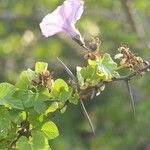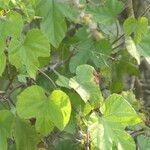Perennial; stems prostrate or twining, densely bristly pubescent.. Leaves ovate, 6.5–17 cm. long, 5–18 cm. wide, acute or acuminate at the apex, cordate at the base, entire or 3-lobed, with the mid-lobe elliptic, thin, green, but adpressedly pilose above, with dense to very sparse and almost nonexistent traces of white-cottony tomentum beneath; veins yellow-bristly beneath; petiole 6–25 cm. long.. Flowers few to many, in lax, rarely rather dense, cymes, very rarely solitary; peduncle up to 23 cm. long; secondary branches up to 9 cm., often forked several times; bracts deltoid, 5 mm. long, 2.5 mm. wide.. Sepals linear-lanceolate to lanceolate, 6–18 mm. long, 2–3 mm. wide, pilose with yellow-bristly hairs; margins glandular.. Corolla pink or mauve, broadly funnel-shaped; tube narrow below, (2.5–)4.5–5.3 cm. long.. Capsule ovoid, 6–9 mm. long, glabrous or pubescent.. Seeds compressed-globose, 3.5 mm. long, yellow-pubescent, also with a small tuft of white hairs 7–8 mm. long.
Perennial with tuberous root. Stems climbing, herbaceous to woody, up to 2.5 m long. Leaves ovate-cordate to suborbicular-reniform, 20-90 mm long, base cordate, sinus broad and shallow, apex acute, margins crenate, entire or 3-lobed, upper surface green, thinly hairy, lower surface softly white-hairy, glabrescent; petioles hairy, 10-50 mm long. Inflorescence lax, 1-many-flowered; peduncle pilose, 20-150 mm long; bracteoles hairy, linear-lanceolate, 7-11 mm long; pedicels up to 15 mm long. Sepals equal, hairy, 10-15 mm long, lanceolate. Corolla funnel-shaped, 40-60 mm long, pink to purple, glabrous or midpetaline areas hairy. Flowering time Nov.-June, mostly Mar.-May. Fruit an ovoid, glabrous capsule, 7-9 mm wide. Seeds ± globose, 3-4 mm long, yellow-pubescent, edges white-hairy.
Leaf lamina ovate-cordate to subcircular-reniform in outline, 2–6·5 × 1·5–5 cm., entire or 3-lobed, acute or acuminate at the apex, thin, green, appressed pilose above, with dense to very sparse and almost non exsistent traces of white cottony tomentum beneath; veins yellow-bristly beneath; mid-lobe elliptic and mucronulate, basal lobes rounded, all constricted at the base and more or less crenate; petiole 1·5–5 cm. long, slender, hairy as in the stems.
Flowers few-to many, in lax, rarely rather dense, cymes, very rarely solitary; peduncle up to 7 cm. long, slender, pilose like the stems and petioles; bracteoles linear-lanceolate, 5–11 mm. long, acuminate-aristate, pilose or hirsute as are the sepals; cyme branches usually short; pedicels 0–10 mm. long.
Corolla broadly funnel-shaped, pink or mauve, 4.5–5 cm. long, glabrous or with a few pilose hairs on the well-defined mid-petaline areas; the limb shallowly 5–lobes.
Thinly hairy, perennial climber to 2 m. Leaves 3-lobed, cobwebby beneath. Flowers pink to purple, sepals thickly hairy, acuminate.
Sepals linear-lanceolate to lanceolate, very acuminate, 6–18 mm. long, pilose with yellow-bristly hairs; margins glandular.
Seeds compressed-globose, yellow-pubescent, also with 2 tufts of long white hairs attached to edges near the apex.
Stems prostrate or twining, slender up to 2·5 m. long, densely bristly pubescent.
Capsule ovoid, glabrous or pubescent.
Perennial from a tuberous root.




